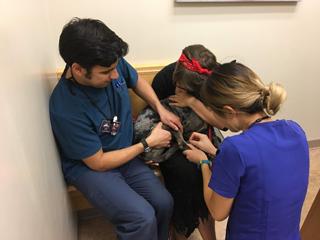
Photo courtesy of Adobe Animal Hospital
An owner holds her dog during a blood draw at Adobe Animal Hospital in Los Altos, California. In general, Adobe doesn't typically enlist owners to hold their pets for blood draws, but they make exceptions for animals who appear especially anxious.
During many a routine visit to the veterinarian, pet owners in exam rooms hear some version of "We're going to take Teddy to the treatment room to draw blood," or "suture a cut," or "get an X-ray." In an emergency, Teddy might be whisked to the back straight from the lobby. Owners dutifully wait for news or the return of their pet.
A growing number of practices want to break down the wall between the client side of the clinic and the treatment area. It's an approach known as "open hospital."
Treating pets with owners present isn't a new idea. Mobile veterinarians and large animal practitioners have long attended patients with owners at their elbow and even pitching in. At companion animal clinics — either by philosophy or due to clinic design — practitioners often provide an array of services, like vaccinations, in exam rooms with owners watching.
The open hospital concept, however, is more intentional and comprehensive: The aim is to keep pets and their owners together, even if things get intense and complicated.
Some open hospitals have been around for decades. Adobe Animal Hospital, started by a mixed animal practitioner in 1964, is described by open hospital advocates as a pioneer of the model. The 30-doctor general practice (with some urgent and emergency care) has two locations in the San Francisco Bay Area. Adobe was purchased in 2019 by Sage Veterinary Centers, which in turn was acquired in 2021 by National Veterinary Associates, one of the world's largest veterinary hospital consolidators.
In the past decade, at least two companies have launched practice groups that operate with an open hospital model. Founded in 2014, Veterinary Emergency Group (VEG) has 34 emergency hospitals in 12 states. Modern Animal, founded in 2020, has four general practice clinics in Los Angeles and one in the San Francisco Bay Area.
Proponents of open hospitals say the model increases trust between owners and clinic staff, enhances care, boosts efficiency and improves job satisfaction for veterinary teams.
The approach has detractors. Some practitioners worry about pet owners interfering — by accident or on purpose — with veterinary teams, stressing out staff members, reducing their efficiency and posing risks to themselves, other clients, pets and staff.
What is open?
Conventional practice layouts generally have a public reception area that connects to individual examination rooms that, in turn, connect to treatment rooms. Clients accompany pets to exam rooms but usually not to treatment areas. Some veterinarians say they avoid referring to staff-only areas as "the back" when clients are present because it can sound ominous.
Open hospitals have lobbies and private exam rooms, too, but much of the care occurs in an open area where several animals might be attended to at the same time. In general, owners are allowed to be with their animals to observe procedures, which, depending on the type of practice, can include everything from inoculations, blood draws, nail trims and ear cleaning to bandaging, eye exams, sonograms, suturing and even CPR. Exceptions usually include euthanasia, which for the most part occurs in private rooms, and X-rays to avoid radiation exposure. Surgical suites may be equipped with viewing windows. Sometimes, although rarely, pet owners may be allowed in the room for routine surgeries, such as a mass removal or a spay, at Adobe.
"We designed the physical space so you can literally stand on the sidewalk and look all the way through the practice, almost," said Dr. Christie Long, vice president of medicine at Modern Animal. "In most of our practices, you can see all the way through to the surgery room door. You can't see in surgery. You wouldn't be an average passerby and see some surgery going on."
According to Long, about 50% of clients choose to join their pets in the Modern Animal treatment area. For those who do, veterinarians and veterinary technicians prepare them for what will happen and why. This is especially important when invasive procedures are needed, such as blood draws, which might involve sticking a needle in the jugular vein near the base of the patient's neck, or cystocentesis, which involves piercing the abdominal wall and bladder with a needle to extract a sample of urine.
"That's something that most people have never seen before," Long said about cystocentesis. "We explain why we do this; how this is the only way to guarantee that the sample will not have any bacteria introduced into it. It makes our team feel great because they think, 'I not only can do this very difficult procedure that most people can't do, I can do it and have an owner see it and see how relaxed that was.' "
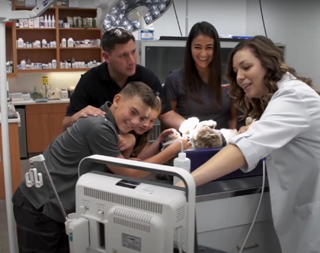
Photo courtesy of Veterinary Emergency Group
In the open treatment room at a Veterinary Emergency Group hospital in New York City, Dr. Monica Sterk (right) reviews with a family their pet's sonogram in real time.
At VEG, people are given the opportunity to head straight into an open triage room immediately after checking in, according to Dr. Monica Sterk, area medical director. "The lobby is more for customers who are waiting on test results or are kind of in between [procedures]," she said. "They're never there for waiting to get into the back."
Sterk, like others who work in open hospitals, fervently believes that the vast majority of pets do better with their people nearby. "There's that 1% that maybe they are better without their people. And there's no reason why sometimes we can't say: 'Hey, your pet is very aggressive because they're protecting you. Do you mind just quickly stepping away, and we'll try to do this,' " she said. "The other 99% are pets comfortable with their people: We do subQ [subcutaneous] fluids, or we do some procedures, or whatever, on their lap. We are OK with having people help us, as long as it's safe for the person and safe for the pet."
VEG does not limit visiting hours. "Clients can stay with their pet as long or as little as they like," Sterk said. "Often, we'll order food for people if they don't want to leave at all. We've created little, like, bedrooms for people in one of our exam rooms. So we'll hook the pet up to fluids and then make a nice little bed, and people will literally sleep with their pet."
Clients set their own limits on what they see, according to Sterk.
"Often, when we say, 'We're going to take blood on your pet,' if there's someone who knows they're squeamish, they are not shy to tell us that," she said. "They'll usually say, 'Ah, I'm going to step away for this.' And that's absolutely fine. But I will tell you, 99% of people love it and stay with their pet and want to be part of the whole experience."
Sterk and other open hospital practitioners contend that the approach increases the speed and the quality of clients' understanding, making it especially suited to emergencies. Owners who are present as problems are discovered and diagnosed could be better prepared than a client waiting in a lobby.
"In the rare chance there is a surgical complication, they're seeing it happen," Sterk added. "They know that you're not just putting around in there. They're seeing that you're trying, you're doing everything possible to help fix whatever is going wrong. It makes it easier to explain if something does go wrong, in my opinion."
Dr. Nicolette Zarday, a former director at Adobe, where she practiced for 19 years, sees open hospital as more of an approach than a particular physical plant.
"To me, open hospital means that pet owners are invited to stay with their pet throughout most of the pet's care, regardless of whether that's in an exam room or a large treatment area," Zarday said. "There is increasing awareness at many practices that a large, noisy treatment area with multiple patients receiving care at the same time is stressful for patients, so increasingly, we are doing things in smaller exam rooms, with the client present."
Zarday now practices at the San Francisco Society for the Prevention of Cruelty to Animals. She adds that while owners are able to be with their pets observing procedures in an open hospital, "in my experience, many don't choose to stick around, but they have the option."
From nail trims to CPR
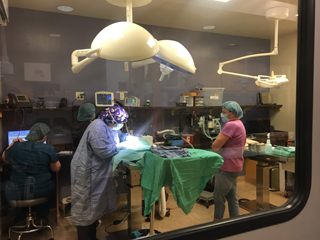
Photo courtesy of Adobe Animal Hospital
Dr. Jane Johnson (left), who has been with Adobe for more than 20 years, sometimes allows owners to scrub up and attend routine surgeries, as with the pet owner on the right. Usually, though, owners who wish to watch surgery view it through observation windows designed for that purpose.
Summer Burke-Irmiter, the president of Adobe, said she knows that some veterinary professionals get nervous when they hear about owners being present for a broad array of interventions, but she maintains it creates opportunities to improve care.
She offered the example of a dog due for a nail trim that barrel rolls and screeches before the technician even touches his paw. "It's the owner who is first saying, 'My dog just turned into an alien in front of me. What happened?' " Burke-Irmiter said. Rather than staff feeling abashed by the difficult encounter, they can parlay the freak-out into an opportunity to talk about using Fear Free techniques or a light sedative to make nail trims a calmer experience.
Burke-Irmiter said owners who witness procedures are more open to veterinarians' suggestions for preventive measures. For example, she's found that owners who have watched their pets have dental work such as teeth cleaning or extractions "were the ones who were scheduling more consistently to come back when we recommended it," she said. "I think we get better compliance with the open hospital than we would otherwise."
Nonetheless, Adobe scaled back its open dentistry more than five years ago because narrating the procedure to owners and answering their questions significantly slowed the process, a consequence that became unacceptable when the waiting period for dental treatments extended to six months, Burke-Irmiter said. The hospital is now looking into the possibility of using video with a technician narrating procedures for clients.
CPR is probably the most controversial intervention in open practice. VEG's Sterk said that because seeing an attempt to resuscitate a patient can be upsetting to some observers, "reception and assistant team members often offer for customers to leave the treatment area if they are uncomfortable watching." The majority opt to stay, she said.
Burke-Irmiter said when she started at Adobe more than 14 years ago, the hospital didn't always allow owners to watch CPR. Now it does, most of the time. She believes clients can learn a lot from the experience.
"Clients know CPR from what's on TV, usually. And that's not what CPR is. CPR is not a clean thing. It's very intense," she said. "We at Adobe do RECOVER standards. So it's an entire team of people working on that pet."
Burke-Irmiter said that an informal study at Adobe found that owners who witnessed CPR were less likely to request additional resuscitation efforts that were unlikely to change the outcome.
Zarday, who said she has done CPR many times with clients present, agrees that seeing CPR can help pet owners, for a couple of reasons.
"One, they can see how sick their pet is," she said. "That can really help them understand the gravity of the situation and help them make decisions."
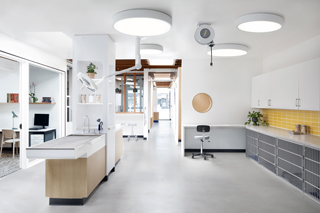
Photo by Tim Hirschmann
As part of its commitment to the open hospital model, Modern Animal clinics, like this one in West Hollywood, California, use large windows and open spaces to encourage transparency.
Secondly, she said, clients who witness everything that goes into resuscitating a pet can better fathom why it tends to be expensive.
She also contends that open hospitals build trust with pet owners and promote staff morale.
"Simply having the client there and inviting them to the back, you're showing that you trust them, and they are also building their trust in you, too," Zarday said. "If your team is well-trained and professional … there's nothing to be afraid of."
She conceded that it can take time to adjust to the performative aspect of open practice, and some professionals will never be comfortable with it. But in her experience, many discover that having an audience can be gratifying, especially for veterinary technicians, who often operate behind the scenes.
"In an open hospital, pet owners really see the incredible skill and professionalism of the nursing staff, as well as the compassionate care, too — that's really on display," Zarday said.
Concerns and questions
For some practitioners, the idea of clients in treatment areas raises a host of questions and concerns. Those with decades in practice see this trend as harkening back to a day when owners were commonly in the picture — and not always for the best.
The main concern for Dr. Dick Headley, a practitioner in Northern Indiana, is the unexpected. "I have spent a half-century doing veterinary work," he said in an email interview with the VIN News Service. "While some people can handle seeing blood, difficult anesthetic recoveries, things not going according to plan, etc., many can't, and I would fear finding out too late." (Headley is board president of the VIN Foundation, a nonprofit started by the Veterinary Information Network, an online community for the profession and parent of VIN News.)
He specifically wondered how clients would respond in the case of cardiac arrest or finding an abdomen full of cancer "with the client and who-knows-who-else watching."
At Headley's practice, clients and patients are seen in exam rooms. Only staff members are allowed in the treatment area. Technicians sometimes do nail trims, blood draws or other procedures in the room if the client is willing and the patient is suitable.
"Any nervous, frightened or aggressive dog or cat is taken into treatment," he said. "Even minor surgeries, suturing small wound[s], removing broken claws, etc., is done in [the] treatment area." He hasn't made exceptions for years.
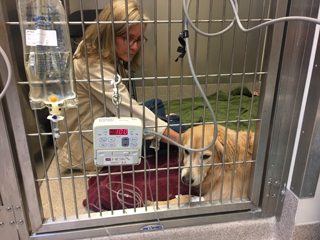
Photo courtesy of Adobe Animal Hospital
An Adobe Animal Hospital client comforts her golden retriever inside a crate in the intensive care unit. Clients may stay with their recovering pets for as long as they wish.
He said the approach minimizes stress on the pet, doctors and staff, and avoids upsetting a client who might see something they don't understand.
Early in his career, Headley was presented with a police officer's pet German shepherd dog whose choke collar was fully embedded in his neck. "With the officer's help (no on-call techs in those days), I anesthetized the dog and removed the collar," he said. "The cop fainted."
In a 2019 discussion on a VIN message board, several veterinarians challenged the premise that owners want to see the nitty-gritty of a pet's care. Others described consequences of letting owners see too much.
Dr. Mark Mills, a practitioner in Maine, has had his share of clients get wobbly. "I have had 5 (yes, five) people pass out when they saw a needle used on their pet, one of whom fell sideways and knocked his elderly wife off the bench. The ambulance took them both away," he posted.
In a recent interview by email, Mills told VIN News that the couple called the next day to apologize. They were "worried about me because I was so upset," he said. "They were both doing fine and continued to be clients for many more years."
Mills prefers to do most procedures without owners present. It wasn't always that way. When he started practicing, he said, open hospital was the status quo by default and without a label. "Owners would do the bulk of the restraint of their pet, and nothing except surgery was done out of sight of the owner," he recalled.
He said Covid-19 precautions that forced clients to remain outside the clinic confirmed his belief "that many (certainly not all) pets do better away from their owners. I'm honestly a lot happier doing it this way, and quite a few clients also expressed that they were more relaxed with the curbside model."
Dr. John Daugherty, a small animal veterinarian for 38 years, said in an interview he's not surprised that some pet owners want to be with their pets in an open hospital setting. However, he said: "I am shocked that there are so many practices that go along with that. In a busy treatment area, the potential for human injury is high. Someone is going to get sued." Daugherty is also a member of the VIN board of directors.
Except for physical examinations and vaccinations, the majority of procedures at Daugherty's small animal practice in Youngstown, Ohio, happen in the treatment area with only staff present.
Daugherty doesn't believe that open-hospital practices necessarily garner more trust from clients. In his experience, he said, "They either trust you or they don't."
He and others say that a restricted treatment area allows for greater efficiency and multitasking — something that overwhelmed practices put a premium on these days.
"Patient flow-wise, it's more efficient to have the tech take the patient into the back," he said, adding that he might use that time to talk with the client or examine another animal.
Like Headley, Daugherty worries about the impact of unexpected reactions from clients. Besides fainting, they might spontaneously shout or scream, which could upset an animal or practitioner and interfere with care, he said.
He is particularly alarmed by reports that pet owners are permitted to hold animals during the visit. This is something he expressly doesn't allow. He said his practice insurance, American Veterinary Medical Association Professional Liability, Business and Personal Insurance for veterinarians, strongly emphasizes keeping owners out of the mix. "If the owner gets bitten, I am liable," he said.
He added, "When dogs aren't behaving well, generally it's because the owners are involved."
Whether pets do better with or without their owners present is a point of debate among clinicians, and captures a fundamental question of whether the open practice model is a good idea. Supporters of open hospitals are putting everything into the belief that having owners nearby is a net positive for all concerned.